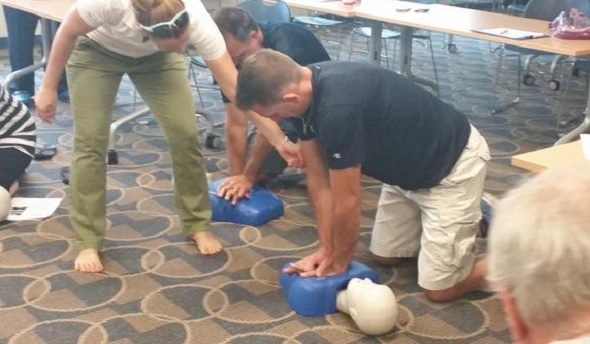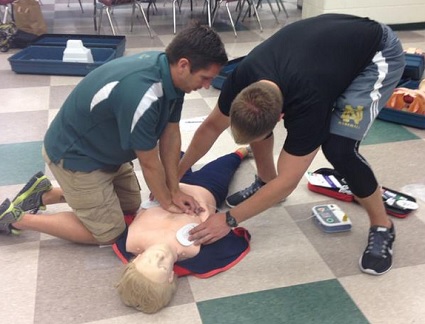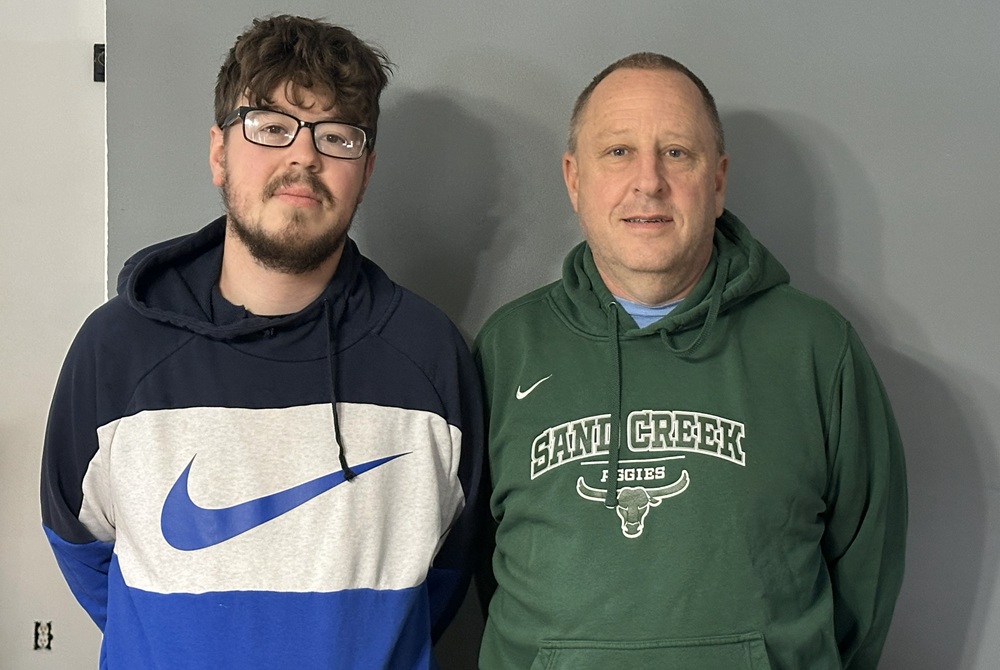
CPR Training, CAP Add to Preparedness
By
Geoff Kimmerly
MHSAA.com senior editor
October 12, 2015
A recent graduate from Ovid-Elsie High School named Chris Fowler started classes this fall at Michigan State University, his days representing the Marauders on the basketball court, football field and golf course now memories as he starts the next chapter of his young adult life.
But his story also will remain a reminder as his high school’s athletic department prepares each year to keep its athletes as safe as possible.
Three years ago next month, Fowler collapsed on the football practice field in cardiac arrest. The then-sophomore was brought back to life by two of his coaches, who revived him with CPR and an AED machine.
There’s no need for athletic director Soni Latz to recount the events of that day when explaining the importance of being ready to respond to a medical crisis – her coaches are well aware of why Fowler survived and understand completely why they too must be prepared.
“Everyone is very aware of what happened and the importance of being trained and knowing what to do, and actually feeling comfortable to step in and administer CPR when needed,” Latz said. “You can feel it’s never going to happen to you, but once it has, it makes you more aware and conscientious to be prepared.”
But Fowler’s story is worth noting on a larger level as varsity coaches at all MHSAA member schools are required this year for the first time to become certified in CPR, and as the largest classes in Coaches Advancement Program history begin course work that includes up to four modules designed to make them aware of health and safety situations that may arise at their schools as well.
The CPR requirement is the most recent addition to an MHSAA thrust toward raising expectations for coaches’ preparedness. The first action of this effort required all assistant and subvarsity coaches at the high school level to complete the same rules and risk minimization meeting requirement as high school varsity head coaches beginning with the 2014-15 school year.
The next action, following the CPR mandate, will require all persons hired as a high school varsity head coach for the first time at an MHSAA member school after July 31, 2016, to have completed the MHSAA’s Coaches Advancement Program Level 1 or Level 2.
In addition, MHSAA member schools this summer received the “Anyone can Save a Life” program, an emergency action plan curriculum designed by the Minnesota State High School League to help teams – guided by their coaches – create procedures for working together during medical emergencies.
“Coaches get asked to do a lot, and even if a school has an athletic trainer or some other health care professional, that person can’t be everywhere all the time. Coaches often are called upon to be prepared for (medical) situations,” said Gayle Thompson, an adjunct assistant professor at Albion College who formerly directed the athletic training program at Western Michigan University and continues to teach CAP sports medicine modules.
“The more (coaches) can learn to handle the situations that can inevitably arise, the better off they’re going to feel in those situations and the better care they’ll be able to offer their athletes. It’s proven that the faster athletes are able to get care, the quicker they’re able to come back to play.”
 Pontiac Notre Dame Prep – which has sent a number of coaches through the CAP program – began a focus on heart safety about five years ago after a student-athlete was diagnosed with a heart issue that allowed her to continue to play volleyball and softball, but not basketball. Athletic director Betty Wroubel said that prior to the student’s diagnosis, the school did provide training in CPR, AED use and artificial respiration; however, that situation put coaches and administrators further on the alert.
Pontiac Notre Dame Prep – which has sent a number of coaches through the CAP program – began a focus on heart safety about five years ago after a student-athlete was diagnosed with a heart issue that allowed her to continue to play volleyball and softball, but not basketball. Athletic director Betty Wroubel said that prior to the student’s diagnosis, the school did provide training in CPR, AED use and artificial respiration; however, that situation put coaches and administrators further on the alert.
Her school offers CPR training also to subvarsity and middle school coaches, using a combination of video instruction from the American Red Cross and in-person guidance by members of the school community who are certified to teach those skills. Students at the school also have received training – and it paid off a few years ago when one of them gave CPR to a baby who had stopped breathing at a local shopping mall.
Portage Central scheduled two sessions this fall for its coaches to receive not only CPR certification, but AED training as well. Central was fortunate to have an American Red Cross first-aid trainer in house, teacher Rachel Flachs, who also is close to the athletic side as the girls swimming and diving coach at Mattawan High School.
Central athletic director Joe Wallace said the training was offered not just to varsity head coaches, but every head coach on every level of the program so that “at least we know that at every given practice, every game, we’d have someone recently trained,” he said.
And he was proud of how his coaches immersed themselves in the subject matter.
“They were putting themselves in scenarios to see how it related to their own sports and asking really great questions,” Wallace said. “It was thought provoking.”
The CAP sports medicine modules are designed to do the same as coaches consider the medical situations they could face. They aren’t designed as “medical training,” said Tony Moreno, a professor of kinesiology at Eastern Michigan University and teacher of all four CAP sports medicine modules. Rather, attendees receive an awareness and basic education on common injuries, injury mechanisms and prevention, and how to create an action plan in the event of an injury incident.
The CAP program touches on a variety of safety topics in several of the available seven levels of coach education.
CAP 1 – which is part of the mandate for new coaches beginning next school year – includes “Sports Medicine and First Aid.” Cap 4 has modules titled “Understanding Athlete Development” and “Strength and Conditioning: Designing Your Program.” CAP 5 includes the session, “Peak Health and Performance.” Attendees also have the option of receiving CPR and AED training as an addition to some courses.
With a quick Internet search, coaches have no trouble finding a variety of resources on sports medicine, performance enhancement, nutrition and healthy living regarding young athletes. “However, some of these sources are more credible and scientifically-based in comparison to others,” Moreno said. “CAP strives on an annual basis to continue to update and improve the quality and credibility of this information and in a face-to-face manner where coaches have the opportunity to ask questions about their experiences and specific programs.”
“Having the CAP requirement will only make them better informed. Many have had this kind of information before, but there’s always something new coming,” Thompson added. “I think we do a good job, not of trying to tell them they were wrong, but maybe taking what they’ve known a step further and making them better prepared – empowering them to do their best.”
Wroubel may understand more than most athletic directors the growing list of tasks coaches are asked to accomplish; she’s also one of the winningest volleyball and softball coaches in MHSAA history and continues to guide both Fighting Irish programs.
But she and Wallace both said the CPR mandate isn’t considered another box to check on a to-do list; there’s enthusiasm because of its importance and the opportunity to carry those skills into other areas of community life as well.
Wroubel has served as a coach since 1975 and said this renewed emphasis on coaches having knowledge of sports medicine actually is a return to how things were when she started. Back then, coaches were responsible for being that first line of medical know-how, from taping ankles to providing ice and evaluating when their athletes should make a trip to the doctor’s office.
“When I first started coaching, we didn’t have sports medicine people, trainers, or team doctors other than for football. You did everything yourself,” Wroubel said. “I think everybody got away from that, but I think it’s coming back because a trainer can’t be everywhere.
“It’s healthy and it’s good for kids. … The more of us with emergency skills, the better we’re able to serve our community.”
PHOTOS: (Top) Portage Central coaches receive CPR training earlier this fall. (Middle) Pontiac Notre Dame Prep coaches practice during AED training. (Photos courtesy of school athletic departments.)

Father & Son Set to Meet for 1st Time Coaching from Opposing Benches
By
Doug Donnelly
Special for MHSAA.com
December 10, 2025
The bantering back and forth is almost complete.
 On Thursday, Mike and Zachary Zyla will finally coach against each other in a varsity girls basketball game.
On Thursday, Mike and Zachary Zyla will finally coach against each other in a varsity girls basketball game.
It’s a game that both coaches circled months ago when Zachary, 26, got his first head coaching job at Britton Deerfield.
“It’s going to be intense,” Zachary said. “I’m sure he will want to win just as badly as I will. Me and our girls have been talking about the game a lot because it’s a game we think we can win. We want to beat Sand Creek.”
Mike Zyla coaches Sand Creek and is Zachary’s dad. He is a longtime coach in cross country and track and added varsity basketball to his resume three years ago. Zachary, who played at Sand Creek, was hired this past offseason to coach the Patriots.
Both schools are in the Tri-County Conference.
“It’s going to be fun,” Mike said. “We’ve been going back and forth about it for a couple of weeks. We’ll see how it goes.”
Basketball is special in the Zyla household.
Zachary’s other brother, Ryan, coaches at a junior college in Minnesota. His sister, Chelsi, played two years of college basketball after graduating from Sand Creek. Their mom, Kirsten, keeps the scorebook for Mike’s games. She is a special education teacher at Britton Deerfield.
“When basketball season rolls around, that’s all we talk about,” Zachary said.
“I guess it’s a little bit in the bloodlines,” Mike said.
After graduating from Sand Creek in 2018, Zachary served in the Navy. He returned home two years ago and served two seasons as his dad’s assistant.
“I just love the game of basketball,” he said. “I’ve been playing since I was probably 2 years old. It’s the thing I’m passionate about. I watch almost every night. If it’s not a live basketball game, I watch clips of old games. I’m just a junkie for basketball.”
Mike said he misses having his son on his bench.
“I miss having him on staff,” Mike said. “He’s really sharp, picking stuff up on the fly. It was nice having him on the sidelines with me. It’s a good opportunity for him, though.”
Please welcome BD’s new varsity girls basketball coach Zach Zyla! Zach comes to BD from Sand Creek where his father Mike is the head girls coach. Zach assisted on the Aggie varsity girls team in the 2024/25 season and is a track assistant coach for the Aggies. Go Patriots! pic.twitter.com/6cpwUw6OW4
— BD Athletics (@athletics_bd) May 2, 2025
Zachary accepted the job in time to have a summer program with BD.
“I’ve always been a big fan of basketball,” he said. “It’s in my blood. I started coaching the Sand Creek hoopsters when I was 16 years old. I knew that’s what I wanted to do. I would say coaching at the varsity level was a goal of mine. It’s always been a dream of mine. I didn’t expect to get a head coaching job so soon. I’d like to get to the next level someday.”
He said he has a few new things for his team to run against his dad.
“He taught me a lot, but our coaching strategies are different,” Zachary said. “I think I’m going to have some things he hasn’t seen yet.”
Sand Creek and BD both lost their season openers Tuesday. Since BD’s game started at 4:30 p.m., Zachary was able to get to Sand Creek to see his dad’s game against Pittsford.
“He was able to scout us,” Mike said.
It’s all in good fun.
“We have a great relationship,” Zachary said. “We bounce ideas off each other all of the time. Even for our first game of the season, we were talking about what we should do, the offenses and defenses. We talk pretty much every day.”
As rare as it is for a father and son to coach against each other, it’s the second time it’s happened in Lenawee County in recent years. Hudson varsity boys basketball coach Jeff Webster coached against his son, Jamison Webster, when Hudson played Tecumseh two seasons ago.
Jamison said it was a great experience, one the Zylas will never forget.
“Coaching and competing against my dad’s teams at Hudson over the last few years has been a great experience,” he said. “We both want to win, being the competitors we are. That being said, the lifelong memories we have made being able to share a sport we both love is what makes it special.”
Zachary said he knows it will be a little different than normal.
“The game’s intensity will be higher than most nights,” he said.
Mike agreed. He doesn’t relish the idea of beating his son, but doesn’t plan on backing down. Since they are both in the TCC, they’ll face off again later this winter.
“We’re both pretty competitive,” he said. “Competitive genes are in the family. I don’t think either one of us will be very happy if we are on the losing side Thursday night.”
 Doug Donnelly has served as a news and sports reporter at the Adrian Daily Telegram and the Monroe News for 30 years, including 10 years as city editor in Monroe. He's written a book on high school basketball in Monroe County and compiles record books for various schools in southeast Michigan. He is now publisher and editor of The Blissfield Advance, a weekly newspaper. E-mail him at [email protected] with story ideas for Jackson, Washtenaw, Hillsdale, Lenawee and Monroe counties.
Doug Donnelly has served as a news and sports reporter at the Adrian Daily Telegram and the Monroe News for 30 years, including 10 years as city editor in Monroe. He's written a book on high school basketball in Monroe County and compiles record books for various schools in southeast Michigan. He is now publisher and editor of The Blissfield Advance, a weekly newspaper. E-mail him at [email protected] with story ideas for Jackson, Washtenaw, Hillsdale, Lenawee and Monroe counties.
PHOTO Britton Deerfield varsity girls basketball coach Zachary Zyla poses for a photo with his father Mike Zyla, right, the varsity girls basketball coach at Sand Creek. (Photo provided by the Zyla family.)

